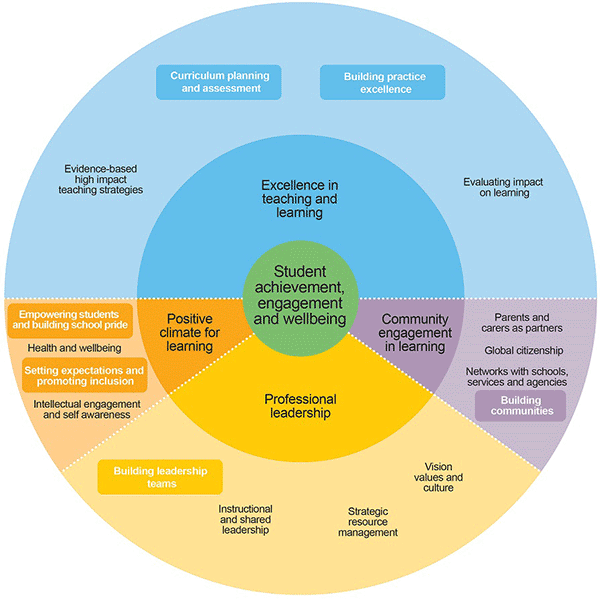This dimension is part of the
Excellence in Teaching and Learning priority.
Navigate the FISO Improvement Model

Overview
To support excellence in practice, teachers develop a shared understanding of what effective teaching and learning looks like in the classroom. While it will not appear identical in every classroom, evidence-based high-impact teaching strategies are consistently informed by the best available research, student feedback, practice and valid evidence of student learning.
Evidence-based high-impact teaching strategies are essential aspects of a comprehensive pedagogical model, such as the VTLM pedagogical model. Continuing professional learning and collaborative practice is needed to sustain authenticity, quality and consistency of teaching strategies to improve student learning.
Improvement measures
Results from system surveys, available in
Panorama, can be used to measure progress, and as success indicators. Suggested surveys include:
- School Staff Survey – the 'use of high-impact teaching strategies' and 'knowledge of high-impact teaching strategies' factors
- Attitudes to School Survey – the 'effective teaching time' factor, as well as specific individual questions which can be used as measures of the individual strategies (Explicit teaching, Questioning, Feedback and Differentiated teaching)
- Parent Opinion Survey – the 'effective teaching' factor.
Growth in NAPLAN data (Top 2 Bands, Benchmark Growth) and trends in VCE scores may be used as long-term measures of school improvement efforts in evidence-based high-impact teaching strategies.In the short term, formative assessment and teacher judgement can be used to identify the learning level of each student based on evidence of what the students knows and can do, and to understand what each student is ready to learn next.
Supporting resources
The VTLM
High Impact Teaching Strategies (HITS),
Pedagogical Model and
Practice Principles
Continuum
The Continuum for Evidence-based high-impact teaching strategies describes a range of proficiency levels (Emerging, Evolving, Embedding and Excelling) that assists principals and teachers to identify areas of practice that require attention in order to deliver improved student outcomes.
Component: The school implements high-impact teaching strategies
Emerging
Leaders provide opportunities for teachers to observe and discuss effective teaching practices and high-impact teaching strategies. Teachers understand the rationale for consistent, high-quality teaching strategies across the school. Teachers commit to improving their practice and actively seek feedback and support from one another. Teachers identify high-impact teaching strategies as a focus for learning and development.
Evolving
PLCs/PLTs agree on a professional learning plan that is focused on incremental changes to classroom practice. PLCs/PLTs select and trial agreed strategies in their own classrooms, then discuss their findings at meetings. Leaders and teachers understand and demonstrate ways in which high-impact teaching strategies support the school’s pedagogical model.
Embedding
PLCs/PLTs engage in challenging and supportive conversations that enhance their learning and build professional resilience and confidence. Teachers have opportunities to observe skilled colleagues, trial and review new strategies, and receive feedback and focused coaching to support improvements to their practice. Teachers challenge and support one another to build and refine their practice to achieve greater consistency in teaching practice across the school. Leaders draw on expertise from their network/Community of Practice or external expertise to assist with the professional learning of their staff.
Excelling
PLCs/PLTs support and challenge one another to continuously evaluate the effectiveness of their teaching strategies to ensure they are achieving impact on learning. Teachers reflect on the effectiveness of their practice using student feedback, peer feedback and achievement data, and take action as required to improve practice. Teachers demonstrate their capacity to translate their professional domain knowledge and curriculum content into highly effective teaching practice. PLCs/PLTs and teachers access expertise from, and share expertise with, a network, Community of Practice or externally.
High Impact Teaching Strategies
10 High Impact Teaching Strategies (HITS) have been brought together to provide a clear link between the ‘Evidence Based High Impact Teaching Strategies’ dimension of FISO and classroom practice. The HITS are 10 instructional practices that reliably increase student learning wherever they are applied. Learn more about High Impact Teaching Strategies.
Case studies
To see examples of how schools in Victoria are implementing the FISO dimension: Evidence-based high impact teaching strategies see:
Evidence-based high impact teaching strategies case studies.
Evidence base
To view the evidence base for the FISO excellence in teaching and learning priority area see:  Evidence - Excellence in teaching and learning evidence base
Evidence - Excellence in teaching and learning evidence base
FAQs
Why should my school engage with this dimension?
It is important that teachers use these evidence based strategies as a way to improve learning, but also consider how they can be used in combination with each other.
To what extent is this dimension being implemented in my school?
Consider whether well-defined, achievable, measurable and student-centred learning goals are in place at your school.
What can my school focus on?
Research identifies the following as high-impact teaching strategies:
- Setting goals
- Structuring lessons
- Explicit teaching
- Worked examples
- Collaborative learning
- Multiple exposures
- Questioning
- Feedback
- Metacognitive strategies
- Differentiated teaching
What does successful implementation look like?
- The school has a consistent approach to the implementation of the selected high-impact strategies
- Teachers work in multi-dimensional teams
- A program of structured, needs-based professional learning including peer observation and moderation is developed and implemented, ensuring teachers are supported/trained in the strategies.
- Adequate resourcing is provided to enable consistent collaborative professional learning for teachers through reflective practice discussions.
What strategies and actions can my school implement?
- Access the literature and existing knowledge to develop a deeper understanding of current evidence-based knowledge concerning high impact, evidence-based teaching practices.
- Integrate one or more evidence-based teaching strategies into a teaching plan so as to accomplish learning goals.
- Implement one or more evidence-based teaching strategies for students in a learning experience
- Use student assessment data and other evidence to evaluate the impact of the strategies
More information
For more information, see:
Excellence in Teaching and Learning priority